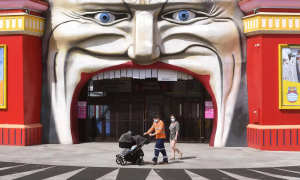Virginia’s governor is requesting $10 million to replace controversial statues in Richmond with inclusive art recognizing a diverse and challenging history.
TWO EQUESTRIAN STATUES were thrust back into news headlines this past weekend following Virginia Governor Ralph Northam’s announcement that he plans to repurpose a stretch of valuable public space in Richmond, the state’s capital.
One statue is a tribute to Confederate General Robert E. Lee, whose image is the last remaining piece of Confederate iconography left standing on Richmond’s famous Monument Avenue. The Lee statue was erected in 1890. The other statue features an unidentified Black man in modern urban attire astride a muscular horse. Entitled Rumors of War, it’s the work of artist Kehinde Wiley and was erected in 2019 in front of the Virginia Museum of Fine Arts (VMFA), about two miles from the Lee statue.
Northam made it clear in Friday’s announcement that he intends to remove Lee from his public perch, while exploring ways to erect more diverse art like that represented by Wiley’s creation. He’s requesting $10 million in next year’s state budget—with hopes to leverage millions more in private donations—to reimagine public art and creative storytelling on the famous avenue. The long-term goal is to repurpose parts of Monument Avenue to better reflect Virginia’s and America’s diverse heritage and not shy away from hard truths about the racially divided past. (How does the world reckon with a racist history?)
“These investments will help Virginia tell the true story of our past and continue building an inclusive future,” Northam said in a statement. “At a time when this Commonwealth and country are grappling with how to present a complete and more honest picture of our complex history, we must work to enhance public spaces that have long been neglected and shine light on previously untold stories.”
Gov. Northam, a pediatric neurologist who was elected to Virginia’s highest office in 2018, tapped the VMFA to lead the charge on repurposing the avenue. The effort has not gone unnoticed by powerful philanthropic interests, including The Andrew W. Mellon Foundation, which announced in October that it would invest $250 million over five years to remove, rethink, and re-contextualize art displayed in public places across the nation.
For more than a century, Monument Avenue served as a shrine-like setting for Confederate luminaries, most prominently General Lee. In recent months the avenue became a flash point for protest against police misconduct and racism and a gathering place for demonstrators, who set up farmers markets, food pantries, and voter registration stations. (Here’s the origin story of Monument Avenue.)
The protesters were united in their demand that the celebration of Confederate figures in Richmond’s public spaces come to an end. Last summer four Confederate statues were removed and placed in storage by order of Richmond Mayor Laver Stoney, who was reelected to a second term in November.
‘A future that’s inclusive’
The same day that Northam announced his intentions for Monument Avenue, Dustin Klein and Alex Criqui were invited to the Virginia Museum of Fine Arts to screen a short film they had created to mark the one-year anniversary of Wiley’s Rumors of War. The digital collage of animation and photographs features the voice of Wiley explaining the motivation for his art and its relevance to the moment. The film was projected onto the side of the museum in a continuous loop.
Klein and Criqui are childhood friends and almost accidental racial activists. Last May, just days after George Floyd was killed by a Minneapolis police officer, Klein—who had been recently laid off as a lighting projectionist for a Richmond area music group—hit upon the idea of displaying digital pictures and messages on the sides of boarded-up buildings. Then in June he and Criqui, a freelance music critic, began projecting the face of Floyd on the Lee statue, soon followed by that of Breonna Taylor and other unarmed Black Americans killed in encounters with police. Their art went viral and attracted international attention.
“The power of the canvas is why our art worked,” Criqui said in an interview. “The Lee monument was specifically created as a symbol of white supremacy. By putting a Black man’s image on the statue, we created something that no one in Richmond could have likely visualized before we did it. It started out as a whim, almost like a prank. We simply wanted to be part of this important conversation.”
This past weekend’s video display at the VMFA was an unlikely collaboration of Wiley—an acclaimed artist whose portrait of Barack Obama hangs in the National Portrait Gallery—combined with the work of two young digital art activists.
This appears to be exactly the type of creative coupling that Governor Northam and the museum’s leadership intends to capitalize on as it explores ways to elevate unheard voices and neglected histories along Monument Avenue. They also hope to jumpstart improvements to the existing Slave Trail in the city’s Shockoe Bottom neighborhood. The neighborhood just off of Richmond’s downtown was once the nation’s second largest slave market. It’s now a gentrified community that offers few indicators of the horrors it once hosted.
“It is about looking to the future, looking to a future that’s inclusive, that’s forward-thinking, and there’s also an element of healing,” Alex Nyerges, director and chief executive officer of the VMFA said in a statement. He also said his staff will soon begin to reach out to art experts, historians, urban planners, and residents to inform their approach on the renovation to the avenue.
As of now, the statues of Robert E. Lee and Arthur Ashe—the Richmond-born tennis champion and noted African-American humanitarian—are the only two statues that remain on Monument Avenue. The irony isn’t lost on Viola Baskerville, who served on Richmond City Council in 1995, when city leaders voted to place a statue of Ashe on the avenue. It was a highly controversial vote, which many hoped would represent the start to a re-casting of the story of Richmond and the Confederacy in a more honest and complete light. Now, a quarter-century after Ashe integrated Monument Avenue, it appears that movement is happening. (Toppling statues is a first step toward ending Confederate myths.)
“It’s a step in the right direction—long overdue,” Baskerville said. “I realize that there are pressing governmental and human needs right now. However, it is a false choice to say that Virginia cannot provide for both the immediate needs of her people and make steps toward fulfilling a commitment to equity and justice.”




